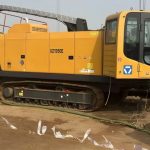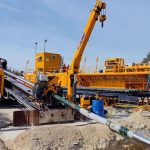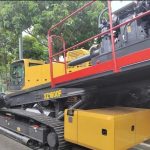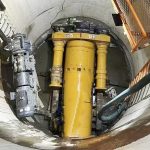Categories
Latest Updates





Because the existing pipelines in the city’s underground are criss-crossed, the pipelines are heavy, chaotic and dense, forming artificial underground obstacles, which brings difficulties and risks to the trenchless construction. The situation of causing economic losses occurs, so the underground pipeline detection of the construction site must be carried out before the trenchless construction. So what are the trenchless pipeline detection methods under complex conditions?
In the detection of urban underground pipelines, not only a single type of pipeline is encountered, but also the situation of dense distribution of underground pipelines and complex conditions exists at the same time, and the dense parallel distribution of multiple pipelines is one of them.
(1). Detection of shallow buried parallel pipelines
When more than two pipelines are buried side by side, the electromagnetic response is much more complicated than that of two parallel infinite current-carrying pipelines. However, when the buried depth, current and spacing are the same, the combined abnormal signal display is also similar to that of a single pipeline. The pipe is abnormal, and its plane center position is the projection of the geometric center of multiple pipelines combined together on the ground. Common methods include direct method, induction method, clamp method, etc.
Use the direct method to charge the exposed pipeline directly, and form a current loop through the ground wire and the ground. Generally speaking, the effect is ideal, but the ground electrode should not cross other pipelines as much as possible.
Use induction methods, including upright induction methods, line pressing methods, etc. The clamp method can also be used for small diameter pipes. According to the induction characteristics of magnetic fields in different directions, the current generated by the side pipeline is minimized. By moving the different positions and directions of the transmitter, the parallel pipelines are detected one by one. For shallow buried (1<2b/h<2, and h<1m), the detection of parallel pipelines with close spacing can get better results.
(2) Detection of deep buried parallel pipelines
When the buried depth of the target pipeline is relatively deep (2b/h<1, and h>1m), when the current of each pipeline is the same, the magnetic field curve shape is more like a single pipe. At this time, the selective excitation method, the indentation method and the oblique indentation method are used for detection. Even if the profile observation and forward and inversion are used for interpretation and inference, the effect will not be good, and the efficiency is also poor.
Most of the vertical and horizontal intersecting pipelines are multiple pipelines that are both parallel and intersecting. The pipelines are buried in different depths, have many intersections, and have large interference, which causes great difficulties in detection work. Electromagnetic methods are often used active, passive, direct method, The induction method cooperates with each other and can be used flexibly to achieve good results.
(1) Overlapping of metal pipes: When using electromagnetic method to detect overlapping metal pipes, due to the mutual interference between overlapping pipes, the observed abnormality is the superposition of the abnormality of the upper and lower pipes. The electromagnetic method can be used to accurately locate them, but the error in depth determination is relatively high. It is large, but the overlapping pipes do not always overlap each other, and the depths can be determined at their bifurcations to infer the depth of the overlapping pipes.
(2) Overlapping of metal and non-metal pipes: Due to the electrical difference between metal pipes and non-metal pipes, electromagnetic methods can be used to locate and determine the depth of metal pipes. Although most non-metallic pipes have steel mesh, their electrical conductivity is still poor compared with metal pipes, so it is difficult to detect non-metallic pipes by electromagnetic method. When the non-metallic pipe has steel mesh, it can also be solved by increasing the power of the transmitter and detecting the diameter of the pipe.
(3) Overlap of non-metallic pipelines: Electromagnetic methods are powerless, and geological radar can be used to detect them. There is a wave impedance difference between the pipeline and the surrounding medium, which provides a basis for the geological radar to detect overlapping pipelines. The difficulty of detecting overlapping pipelines lies in the depth detection at the overlapping places. Whether metal pipelines or non-metallic pipelines overlap, as long as there is an appropriate distance between them, GPR can solve this problem well.
Practice has shown that in order to ensure the smooth progress of construction, scientific, reasonable and effective pipeline detection technology should be adopted for pipeline detection under complex conditions. proceeded smoothly.
